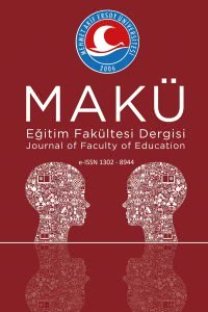Üniversite Öğrencilerinin "Analiz" Konularındaki Hataları ve Kavram Yanılgıları
Bu çalışmanın amacı, matematiğin önemli alt dallarından olan analiz konularının, öğrenciler tarafından öğrenme düzeylerini, hatalarını ve kavram yanılgılarını cinsiyet açısından incelemektir. Araştırmanın örneklemini 2002-2003 öğretim yılında Yüzüncü Yıl Üniversitesi Eğitim Fakültesi İlköğretim Bölümü Fenbilgisi ve Matematik Öğretmenliği Programı ikinci sınıf öğrencilerinden toplam 79 öğrenci oluşturmaktadır. Bu Çalışmada 10 soru içinden 4 soru üzerinde durulmuştur. Elde edilen bulgularda Fenbilgisi Öğretmenliği öğrencilerinde, 1. ve 2. sorularda kızlar daha fazla doğru soru yapmasına rağmen 3. soruda erkekler daha çok doğru yapmıştır. 4. soruda ise hiç kimse doğru yapmamış, fakat bu soruda erkekler kızlardan daha az yanlış yapmıştır. Buna karşın Matematik öğretmenliği öğrencilerinde, 3 soruda da erkek öğrencileri, kız öğrencilere göre daha başarılı iken 4. soruda doğru yanıtlarda bir eşitlik söz konusudur. Verilerin analizinde t-testi kullanılmıştır. Yapılan analiz sonucunda kız ve erkek öğrenciler arasında serilen karakter tayininde her iki bölümde de anlamlı bir farkın olmadığı görülmüştür. Elde edilen hatalar şu şekilde özetlenebilir: 1. Bir serinin genel terim kavramı yeterince öğrenilmemiş, 2. Yakınsaklık kriterleri birbirine karıştırılmış, 3. Oran kriteri her seri için kullanılmaya çalışılmış, 4. Mukayese (Karşılaştırma) kriteri yeterince anlaşılmamış.
Anahtar Kelimeler:
analiz
University Undergraduate Students' Mistakes and Misconcepts in the Topics of "Analysis"
The aim of this study is investigate student’ level of understanding, mistakes and misconcepts in the topic in analysis that is a sub-branch of mathematics in terms of male and female students. Totally 79 students from the department of Science and Mathematic Teacher Training, Faculty of Education, University of Yuzuncu Yil, participated to the study in the 2002-2003 academic year. The data for the study is taken from an examination that includes 10 open ended questions, but this study mainly examines four questions out of ten. According to the findings, students in the department of Science Teacher Training; although the females answered the 1st and 2nd questions correctly compared to the males, the males answered the 3rd questions more correctly compared to the females. Besides this, none of the above stated sex groups answered the 4th question correctly, but the male group made less mistakes compared to other one students in the department of Mathematic Teacher Training; although the males answered the 1st, 2nd and 3rd questions correctly compared to the females, both males and females answered the 4th question equal number correctly compared. t-test was used in the analysis of the study. As a result, in identifying the character of serie and sequence, there is no significant differences between these groups. The marked mistakes in the all students’ papers can be summarised as follows: 1. A general term concept of a serie is nor fully understood, 2. The criterions of convergenced are confused, 3. The ratio criterion were used for each seri, 4. The comparative criterion is not fully understood.
Keywords:
analysis,
___
Akdeniz, A.R., Bektaş, U. ve Yiğit, N.(2000). “İlköğretim 8.Sınıf Öğrencilerinin Temel Fizik Kavramlarını Anlama Düzeyi”.Hacettepe Üniversitesi Eğitim Dergisi. Cilt 19,5-14.Aksu, M.(1991). “Matematik Öğretiminde Yöntemler” (Matematik Öğretimi). Anadolu Üniversitesi Yayınları. No 401.
Balcı, M. (1996). Analiz. Ankara Ertem Basım Yayın Dağıtım Ltd. Şt., Cilt 2.
Bilgin, T. Ve Akbayır, K.(2002). “Lise 1. Sınıf Öğrencilerinin Ondalık Sayıları Yorumlama ve Uygulamada Sahip Oldukları Kavram Yanılgıları”. Gazi Üniversitesi Kastamonu Eğitim Dergisi. Cilt 10, No 1, 109-118.
Demirci, N.(2004). “Web Tabanlı Fizik Programını Kullanarak Öğrencilerin Kuvvet Ve Hareket Konularındaki Başarı Ve Kavram Yanılgıları Üzerine Bir Çalışma”. Eğitim ve Bilim Dergisi. Cilt 19, Sayı 131, 61-84.
Dönmez, A.(1998). Analiz II. Van Yüzüncü Yıl Üniversitesi Matbaası.
Driver, R. And Easley, J.(1978). “Pupils And Paradigms: A Review Of Literature Related Of Concept Development In Adolescent Science Students”. Studies in Science Education. 5, 61-84.
Finegold, M. And Grosky, P.(1992). “Learning About Forces: Simulating The Outcomes of Pupils Miscoceptions” Instructional Science. 17, 251-261.
Gilbert, J.K., Watts, D.M. and Osborne, R.J.(1982). “Student Concepts of Ideas In Mechanics”. Physics Educations. 17, 62-66.
Helm, H. (1980). “Misconceptions In Phiysics Amongst South African Students” Physics Educations. 15(2), 92-97.
Kaput, J., J.(1997). “Rethinking Calculus:Learning And Thinking”. The American Mathematical Monthly. 104, 8., 731-737.
Met, M.(1998). “Seriler’de Problem Çözümleri”, Yayınlanmış Bitirme Tezi, Yüzüncü Yıl Üniversitesi, Fen Bilimleri Enstitüsü.
Oliver, A.(1989). “Handling Pupils’ Misconceptions”. Delivered at The Thiteenth National Convention on Mathematics, Phiysical Science and Biology Education. Pretoria, 3-7.
Pines, A. And West, L.(1986). “Conceptual Understanding And Science Learning: An Interpretation of Research Within Sources of Knowledge Framework”. Science Education. 70 (5), 583-604.
Posner, G. J., Strike, K. A., Hewson, P. V. And Gertzog, W.A. (1982). “Accommodation of a Scientific Conception: Toward A Theory of Conceptual Change” Science Education. Vol.66:211-227.
Ubuz, B.(1999). “10. Ve 11. Sınıf Öğrencilerinin Temel Geometri Konularındaki Hataları ve Kavram Yanılgıları”. Hacettepe Üniversitesi Eğitim Dergisi. Cilt 15, Sayı 16-17, 95-104.
- ISSN: 1302-8944.
- Yayın Aralığı: Yılda 2 Sayı
- Başlangıç: 2018
Sayıdaki Diğer Makaleler
Yazılı Kanyon (Sütçüler, Isparta) Tabiat Parkı'nın Turizm Açısından Önemi ve Kullanımı
Liselerimizde Uygulanan Coğrafya Öğretim Programının Sorunları ve Çözüm Önerileri
Yabancı Dil Öğretiminde Soru Sorma Teknikleri ve Önemi
İlköğretim Denetmenlerinin Denetim Süresince Karşılaştıkları Sorunlar
Gelincik (Isparta)- Askeriye (Burdur) Köyleri Arasındaki Karayolu'nda Kaymalar
Lise 2. Sınıf Öğrencilerinin Manyetizma Kavramlarını Günlük Hayata Uygulama Becerilerinin Tespiti
DİLEK ERDURAN AVCI, Rahmi YAĞBASAN
Eğitimde Farklılıkların Yönetimi Ölçeğinin Uygulanabilirliği
